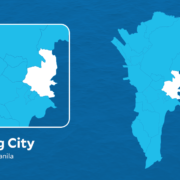Reclaiming our neighborhoods from harm

One of my fondest childhood memories is running home with a warm bowl of champorado from the sari-sari store around the corner. For many Filipino kids, being sent to the sari-sari store to buy suka, mantika, and other essentials is a formative experience. It is one of our first small adventures, a test of independence, and for most, a rite of passage.
Despite modern conveniences, sari-sari stores have endured because they are more than just retail spaces. Built into homes and run by families, they are community hubs woven into the rhythm of daily life. With their high foot traffic and deep roots, they have become prime real estate for advertising.
For decades, beverage and alcohol brands competed to plaster sari-sari stores with branded tarpaulins. But in recent years, in place of soda and alcohol ads, store walls are now painted to mimic cigarette packaging. The bright red walls are impossible to miss, as entire neighborhoods have been transformed into tobacco billboards.
As stores became saturated with ads for addictive and harmful products, cigarettes, alcohol, and sugary drinks cemented themselves as fixtures in Filipino life, ever-present at gatherings, on television, and in the very places we call home. Their ubiquity has desensitized us to their risks and embedded them in the consciousness of young minds.
This is precisely what the Manila episode of “Somebody Feed Phil” on Netflix captured—a perfectly Filipino moment with humble food, warm hospitality, and a tobacco ad sneaking into the frame. As the show celebrated our culture, it inadvertently exposed just how normalized tobacco advertising has become in our daily lives—so normalized that it now appears in global media without anyone batting an eye. Scenes like this matter, and simply blurring out harmful signage can make a difference.
It’s disheartening that, as Filipino food is finally having a moment on the world stage, tobacco is stealing the spotlight. But it’s hardly surprising. In almost every neighborhood, every captured moment is marked—or more aptly, marred—by a tobacco ad in the background, as store owners become easy prey for corporations that pay little to nothing for such exposure.
What are a few tarpaulins here, a few cans of paint there, in exchange for 24/7 visibility? Certainly not a bargain for the communities that bear the true cost—in disease, in untimely deaths, and in children who grow up seeing these ads daily and accepting them as normal long before they understand their real consequences.
I’m lucky that my earliest memory of a sari-sari store was of buying comfort food on my own. Not every child has that kind of memory. For some, their first errand may have been to buy cigarettes or alcohol—a chore made possible by their accessibility and omnipresent marketing.
Advertising for tobacco, unlike other harmful products, is regulated under existing laws. But the rules are riddled with gaps, especially when it comes to advertising at points of sale. Corporations exploit these loopholes through signage and storefront makeovers that effectively turn sari-sari stores into larger-than-life tobacco ads.
And it seems their strategy is working. Smoking and vaping among Filipino youth are rising at alarming rates. We know that early exposure to advertising is a proven driver of initiation, and the more visible these ads are, the easier it is for kids to believe that trying them is just part of growing up.
Baguio City has shown what’s possible when it cracked down on illegal tobacco signage with visible—or rather no longer visible—results. Other local governments need to catch up.
Our national agencies must do their part, too. The Inter-Agency Committee on Tobacco exists for this very reason. It must act with urgency to hold corporations accountable for rampant displays of tobacco ads in outdoor spaces—through illegal tarps, signage, and entire storefronts.
Enforcement alone will never be enough. If we truly care about the future of our children and communities, we need to go further. It’s time to adopt an absolute ban on tobacco advertising, promotion, and sponsorship. No loopholes. No tarps. No painted walls.
Our Asean neighbors—Lao PDR, Myanmar, Singapore, and Thailand—have already implemented absolute or comprehensive bans. The Philippines shouldn’t lag behind.
And while we’re at it, we must begin to confront the unchecked marketing of other harmful products in spaces where children live, play, and grow.
I hope the next generation remembers sari-sari stores the way I do— for the thrill and joy of being trusted to buy something on their own, not for the first time they purchased a cigarette or a bottle of alcohol. And I hope our sari-sari stores continue to endure as a uniquely Filipino pillar of community and a space for childhood wonder.
—————-
Fatima Laperal is the executive director of HealthJustice, a nonprofit organization that aims to bridge the gap between health and law through evidence-based advocacy and reform. The organization champions policies that protect children and communities from the harms of tobacco and unhealthy food.

















